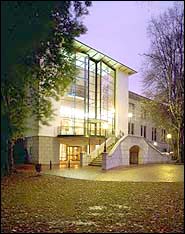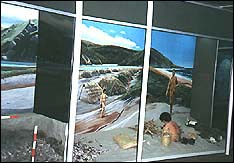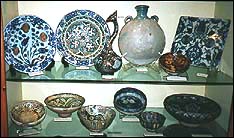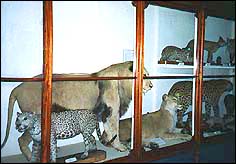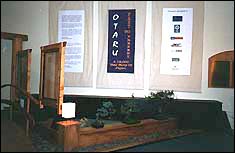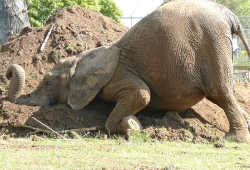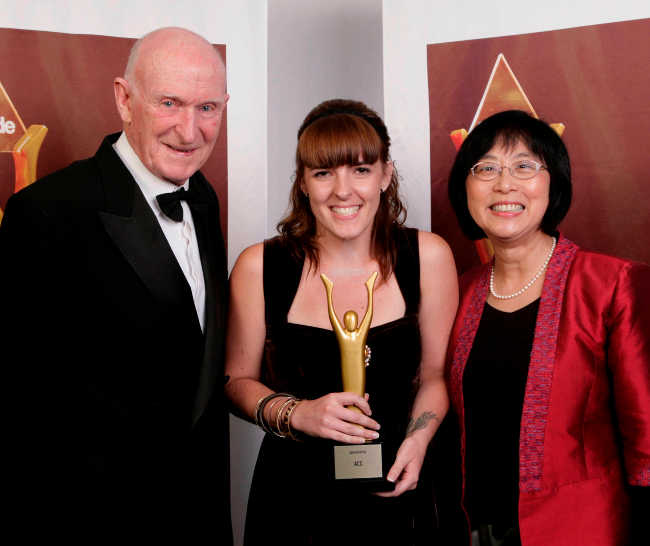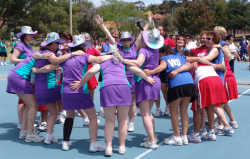Dorothy – 22/8/98
A vibrant place with changing exhibitions and long-term displays to interest visitors of all ages.
|
|
| The entrance to the Otago Museum |
The Otago Museum is a place not to be missed when you visit Dunedin. The long-term displays are constantly being upgraded and added to and the special displays are frequently changed to offer something new. In this year when Otago is celebrating 150 years of organised settlement there are some extra features of interest.
When did it all begin? In 1868, just twenty years after the first settlers arrived in Dunedin, the first museum was opened. The Scots who founded the Otago settlement had a great concern with education and from 1858 moves were afoot to build an Athenaeum to contain a reading room, a library and a museum. This was to be a museum of local and provincial natural history.
An early emphasis on mineral research Dr (later Sir) James Hector was appointed by the Provincial Government to undertake a geological survey of Otago and was asked to purchase a set of typical mineral specimens before he left London. These were to be displayed in the museum and as Dr James discovered rocks and minerals of importance in the province these were to be added to the collection. Such exhibits were thought to be of particular interest in the gold rush days. By the time the small museum was opened in the south gallery of the Post Office in 1868 the number of specimens had increased to five thousand.
Museum building opened in 1877 In 1977 the Museum was transferred by Act of Parliament to the University of Otago and a close link with the University has continued.
The Hocken Wing 1910 When Dr Thomas Hocken gifted his valuable collection of books, manuscripts and ethnographic material, more space was needed and with local subscription and a government subsidy the money was raised for a new wing – the Hocken Wing.
The Willi Fels Wing 1929 The collections in the museum grew as valuable ethnographic, archaeological and classical collections were established. Mr Willi Fels presented his extensive collection of coins, Oriental arms and Maori material. A group of businessmen raised money which with a government subsidy funded the building of the South Wing, now known as the Willi Fels Wing.
Centennial Memorial Wing opened debt-free 1963 The growth of the museum and the achievement of opening this wing debt-free are evidence of how it is valued by the local community.
The Hocken Library – a research library open to the public The Hocken Library has moved to a larger site, but is still in close proximity to the University and the Museum. This is a research library and is accessible to the public. Thanks to a trust fund, The Friends of the Hocken Collections, and donated material, there are frequent additions to this resource. In addition to books it has a large collection of archives and photographs.
Some Long-Term Features Of The Otago Museum Tangata Whenua Gallery Including Southern Maori Collections and an exhibition on Polynesia and Melanesia These are on the floor where you enter.
|
|
| Maori Hall, Shag River mouth reconstruction |
People of the World This gallery includes Egyptian material, a very fine collection of Greek ceramics and a range of other ceramics, textiles and costumes, and other artefacts from different parts of the world.
|
|
| Islamic ceramics |
Natural history Some impressive natural history displays relate to insects, New Zealand birds, and marine life. Recently the collection of insect material was greatly increased by the gift of 108,000 pinned and labelled specimens from the private collection of Brian Patrick. It included specimens of fourteen insect orders, with major holdings of New Zealand moths, butterflies, beetles, stoners, caddis and bugs.
“The Animal Attic”
|
|
| Animal Attic |
This section has original natural history displays from many parts of the world with animals, birds, and geological samples, all displayed in the style of a Victorian museum. It is appropriately housed on the top floor of the original building built in the Victorian era with a beautiful kauri interior.
Special displays Some of these feature material from the extensive Otago Museum resources in storage like the recent display of Chinese textiles and costumes which will be the subject of an article in NZine in two weeks, and others are visiting exhibitions like ‘Reckoning with the Past’, a recent exhibition, of contemporary Chinese painting. Some show the work of local art and craft groups.
Exhibitions coming up include Aladdin’s Cave, The Patient Planet, and Twenty Five Years of artist Graeme Sydney.
Acknowledgement of Dunedin’s American sister city, Portsmouth Portsmouth, Virginia, USA is a sister city of Dunedin and in Portsmouth Week the museum organised activities focused on the ports of Otago and Portsmouth and the navy as Portsmouth has strong links with the American Naval forces.
Exhibition from Dunedin’s Japanese sister city, Otaru ‘Otaru Past to Present, a 12,000 Year Story’
|
|
| Entrance to the Otaru exhibition |
>From August 4 1998 until mid-February 1999 there is an exhibition from Dunedin’s Japanese sister city, Otaru on Hokkaido, the northern island of Japan. This magnificent cultural exhibition features a collection of exceptional antiquities – finely crafted tribal art and artefacts of the Ainu people, early Japanese historic artefacts and photographs from northern Japan.
Treasures never before seen outside Japan Exquisite treasures, some never before seen outside Japan, have been loaned by the Otaru Museum, the Nibutani Ainu Culture Museum and the Historical Museum of Hokkaido for this exhibition held at the Otago Museum and organised by Otaru to mark the 150th anniversary of organised settlement in Otago.
Early archaeological artefacts Archaeologial material shows something of the life of the Jomon people who were living by hunting, fishing and gathering food some 8000 years ago. These people represent the first stage in the formation of Japanese culture. There are also objects from the next stage – the Satsumon culture.
The Ainu culture The Ainu, the indigenous people of the island of Hokkaido in Northern Japan, flourished in the region of Otaru for centuries. This exhibition includes Ainu art which attracted great interest recently when exhibited in Europe. As it is rarely seen outside Japan this is a unique opportunity for people in New Zealand to view it.
Our Story in Stamps In the People of the World Gallery there is a display of stamps showing how the story of Otago and Southland can be found on New Zealand postage stamps. Beginning with the coming of the Polynesian people it includes many of the events of importance before the planned settlement in 1848. Many aspects of life in the south in the next 150 years are encapsulated in the stamps. All the stamps are part of the Otago Museum’s own collection and the display was organised by Honorary Curator, Mel Carr.
Discovery World This is a hands-on science centre with changing displays on different aspects of science and technology. It includes some natural history displays which are always there, including live terrapins, frogs and guinea pigs. Discovery World regularly hosts touring exhibitions. Visitors can phone the museum to check on what is currently being shown.
Admission Admission to the museum galleries is by ‘Donation please’. Discovery World and some special exhibitions carry a small admission charge.
More expansion to the buildings planned Further building plans for 1998-2000 will cause some disruption, but the major part of the museum will always be available to the public with permanent and short term displays.
Be sure to put the Otago Museum on your list of places to visit.
Read the other articles published in Nzine about:
- The museum’s textile curator
- A display of Chinese textiles
- The museum’s developments in 2000 and 2001
- Southern Land, Southern People Exhibit

